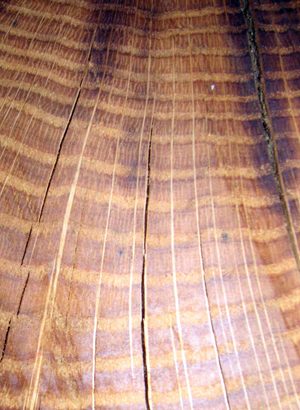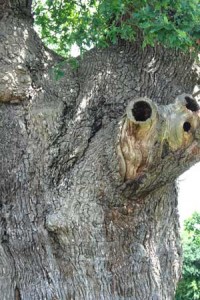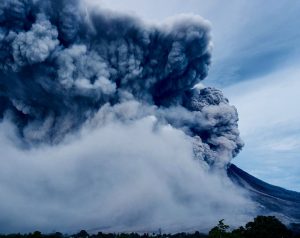Annual rings, dendrochronology and climate change.

Dendrochronology seeks to gather information from the annual rings of trees, dated to their year of formation. As trees age, they form new distinctive rings, outward from the centre, and each year a circle of new, dead wood is formed (by the cambium) around the trunk of most trees. The annual rings form because the water conducting xylem vessels or early wood formed in late spring and early summer (when growth is rapid) are wider and lighter than those formed in late summer and early autumn, which are narrower and darker (sometimes called the late wood). A light and dark ring together constitute one year’s growth. In winter, there is no growth.
Trees and their annual rings are essentially long term recording devices that ‘house’ information about climatic variations, past climates and ecosystems; they can even offer insights into historical events. From an annual ring, it is possible to extract information about precipitation, temperature and other climate data about that year.
In recent times, the methodologies for extracting information from tree rings have improved and expanded. For example, oxygen isotope analysis can reveal the source of the water that a tree took up centuries ago and also suggest whether it was from a hurricane or a severe thunderstorm. There are now a significant number of laboratories using advanced techniques to explore historical climate change through dendrochronology - such as The Laboratory of Tree Ring Research at the University of Arizona.  This and other laboratories now hold information on tree rings from some 4000 sites across the globe - helping to build a detailed picture of temperature and climate through historical times. Trees such as long lived bristlecone pines offer up much valuable information, especially so when their data is combined with that of trees that died hundreds of years ago but have remained intact in cold, dry and high altitude environments. The most common annual rings used in dendrochronology are from bristlecone pine, fir and spruce, but oak is also valuable. Using living and relic oaks, scientists have developed an “oak ring chronology” for Europe that dates back through thousands of years (the Holocene Period). This oak annual ring timeline has been used to date various wooden artefacts with great accuracy, for example, timbers from buildings, boat frames, and furniture.
This and other laboratories now hold information on tree rings from some 4000 sites across the globe - helping to build a detailed picture of temperature and climate through historical times. Trees such as long lived bristlecone pines offer up much valuable information, especially so when their data is combined with that of trees that died hundreds of years ago but have remained intact in cold, dry and high altitude environments. The most common annual rings used in dendrochronology are from bristlecone pine, fir and spruce, but oak is also valuable. Using living and relic oaks, scientists have developed an “oak ring chronology” for Europe that dates back through thousands of years (the Holocene Period). This oak annual ring timeline has been used to date various wooden artefacts with great accuracy, for example, timbers from buildings, boat frames, and furniture.
Tree ring research may be divided into three broad categories :
- dendro-climatology, the analysis of annual rings for past climate data
- dendro-archaeology, the study of annual rings to interpret how past climate affected human societies and
- dendro-ecology, this tries to reconstruct past ecosystems.
At the moment, dendrochronology is important in reconstructing a picture of the past climate, so that we can compare our present and changing climate with historic climate change. It would seem that the climate of the last 50 - 100 years is far from the ‘norms’ of the last ten thousand years.
 One example of dendron-chronological research is the investigation into the variation of the jet stream. The jet stream is the fast moving current of air high above the North Atlantic. It has massive influence on the weather across the U.K and Europe. Systematic records of weather events began in the mid to late nineteenth century, so there is limited evidence of the jet stream’s movement prior to then. It was thought that its path was stable for many centuries but became less predictable in the twentieth century.
One example of dendron-chronological research is the investigation into the variation of the jet stream. The jet stream is the fast moving current of air high above the North Atlantic. It has massive influence on the weather across the U.K and Europe. Systematic records of weather events began in the mid to late nineteenth century, so there is limited evidence of the jet stream’s movement prior to then. It was thought that its path was stable for many centuries but became less predictable in the twentieth century.
Valerie Trouet, a dendrochronologist, led a team that sampled 400 trees from the Balkans and another 200 in Scotland. The jet stream flows between these two locations. Analysis of the tree rings revealed a range of temperatures and the incidence of fires over time, which can be associated with jet stream behaviour. More extreme positions of the jet stream are associated with more extreme climate events - in the form of heat waves and storms. The tree rings indicate that fires happen more in the Balkans when the Jet Stream is in a more extreme southerly position. Dr. Trouet has said “The recent rise in variance [of the position of the jet stream] is unprecedented in 300 years”. The shifts in the jet stream have largely come about since the 1960’s, and this suggests that it is the result of human induced climate change.

Annual rings can also provide evidence of volcanic activity. When there is a large scale volcanic eruption, million of tons of sulphur dioxide and ash particles are shoot into the atmosphere. The ash and aerosols (formed from the acidic gases) linger in the atmosphere, lowering the solar radiation reaching the earth’s surface. In 1568, there was a massive volcanic eruption in Indonesia (Mount Kelud), the cooling of the earth’s climate in subsequent years can be seen in the annual rings of trees - from five different locations around the globe !
Analysis of annual rings also showed that during the subsequent decades (up to circa 1634), there was some natural variation in the climate, which resulted in expansion of the subtropics, which in turn pushed desert regions further north. During this time, the Ottoman Empire began to decline, the Ming dynasty collapsed and the early settler’s Jamestown colony in Virginia was abandoned, suggesting, these events were in part at least, climate-related. “The way society handles a drought politically is also part of the picture” to quote Dr. Trouet.
Tree ring data from Mexico and other parts of North America indicate that there was a severe drought in the sixteenth century. This drought extended from Mexico to the boreal forest, and from the Pacific to the Atlantic Coast. The only areas exempt from the drought were coastal regions. This extended drought coincided with major epidemics of 'cocoliztli' (in 1545 & 1576). This was a swift and lethal disease, with a high death rate. It may have been a form of haemorrhagic fever, and was probably responsible for the deaths of a large number (millions) of the indigenous population of Mexico. It has been suggested that the virus ‘escaped’ from rodents, when their populations exploded when wet years followed prolonged periods of drought. Further information from tree ring analysis supports the idea that the drought was occasionally interrupted by wet years; for example, in 1545.
(Volcanic eruption - image from stocksnap at Pixabay.com)
Comments are closed for this post.
